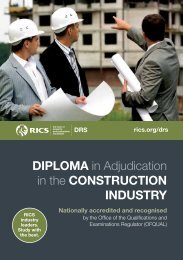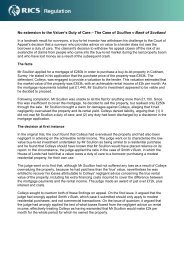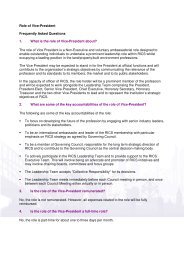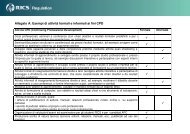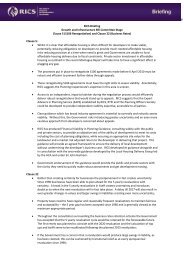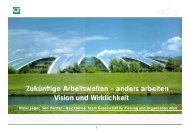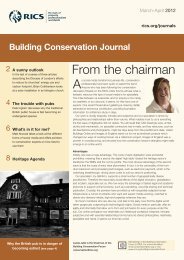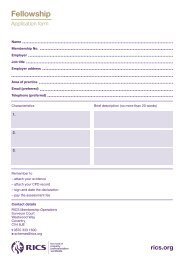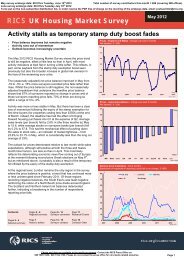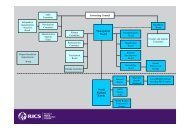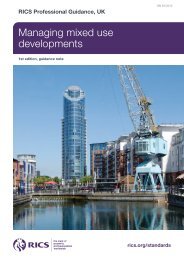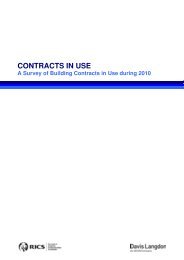Create successful ePaper yourself
Turn your PDF publications into a flip-book with our unique Google optimized e-Paper software.
<strong>Greening</strong> <strong>Make</strong> <strong>Good</strong><br />
<strong>Australia</strong>
Foreword<br />
The built environment is one of the most critical areas in which we can<br />
reduce mankind’s impact on our environment. <strong>RICS</strong>, being the world’s<br />
largest property and construction organisation, has the obligation<br />
of using its reach and influence to bring about the changes that are<br />
needed.<br />
<strong>RICS</strong> has produced this Guide to <strong>Greening</strong> <strong>Make</strong> <strong>Good</strong> to assist<br />
the property industry in reducing waste at lease end through valuing<br />
the materials used and trying to avoid waste through planning,<br />
agreement, sharing responsibility and ensuring that the parties that<br />
will do the work will do so in an environmentally acceptable manner.<br />
It is hoped that this document has started a process that will reduce<br />
the huge amount of waste from <strong>Make</strong> <strong>Good</strong>. <strong>RICS</strong> welcomes<br />
feedback so that industry comments can be used to evolve <strong>Greening</strong><br />
<strong>Make</strong> <strong>Good</strong> into a system that meets high environmental standards<br />
and further reduces waste and damage to the environment.<br />
John Goddard F<strong>RICS</strong><br />
Chairman, <strong>RICS</strong> Oceania Sustainable Steering Group<br />
<strong>RICS</strong> gratefully acknowledges the work of the <strong>RICS</strong> Oceania<br />
Green Lease working party in the drafting of this guide:<br />
1<br />
Copyright<br />
Published by <strong>RICS</strong> Oceania (First Edition<br />
2009) <strong>RICS</strong> Oceania, Level 16, 1 Castlereagh<br />
Street, Sydney, NSW, 2000.<br />
No responsibility for loss occasioned to<br />
any person acting or refraining from action<br />
as a result of the material included in this<br />
publication can be accepted by the author or<br />
publisher. © Copyright <strong>RICS</strong> February 2009.<br />
Copyright in all or part of this publication rests<br />
with <strong>RICS</strong>, and save by prior consent of <strong>RICS</strong>,<br />
no part or parts shall be reproduced by any<br />
means electronic, mechanical, photocopying,<br />
recording or otherwise, now known or to be<br />
devised.<br />
Disclaimer<br />
This is a guide only. It is not intended to be<br />
an instruction manual, nor a detailed step by<br />
step process which must be followed, but<br />
rather a guide to encouraging the process<br />
of ‘<strong>Make</strong> <strong>Good</strong>’ to be less wasteful and less<br />
environmentally damaging. This guide does<br />
not provide legal advice and is general in<br />
nature. You are advised to take legal advice<br />
from a professionally qualified legal advisor.<br />
John Goddard F<strong>RICS</strong>, J Goddard & Co<br />
Judith Knott M<strong>RICS</strong>, JCK Consulting Pty Ltd<br />
Melinda Graham, Thomson Playford Cutlers<br />
Tony D’Agostino, Herbert Geer<br />
Simon Harrison, Herbert Geer<br />
<strong>RICS</strong> acknowledges Nick Penny from Intensive Care Property Solutions for his input on the concept of a <strong>Make</strong> <strong>Good</strong> Deed.
Contents<br />
1. Introduction ................................................................................................... 3<br />
2. Tenants’ <strong>Make</strong> <strong>Good</strong> Obligations and Landlord’s Rights ................................ 4<br />
3. Repair Covenants and <strong>Make</strong> <strong>Good</strong> ................................................................ 4<br />
4. Who Should Carry Out The Works? ............................................................... 5<br />
5. Recognising and Factoring in Competing interests ........................................ 5<br />
6. Guidance to Tenants to Minimise <strong>Make</strong> <strong>Good</strong> ................................................ 6<br />
6.1 Assessing the Premises Before Signing a Lease .....................................<br />
6.2 Planning Your Fit Out<br />
7. <strong>Make</strong> <strong>Good</strong> – New Approaches ..................................................................... 7<br />
7.1 Agreement of <strong>Make</strong> <strong>Good</strong> at Lease Commencement<br />
7.2 What is the Best Environmental Approach for New Leases?<br />
8. <strong>Greening</strong> <strong>Make</strong> <strong>Good</strong> Advantages ................................................................. 8<br />
8.1 Landlord<br />
8.2 Tenant<br />
8.3 Issues to Address<br />
9. Using a <strong>Make</strong> <strong>Good</strong> Deed at Lease End to Reduce Cost and Waste ............. 9<br />
9.1 Preparing a <strong>Make</strong> <strong>Good</strong> claim<br />
9.2 <strong>Make</strong> <strong>Good</strong> Deed<br />
9.3 Advantages of the <strong>Make</strong> <strong>Good</strong> Deed<br />
9.4 Disadvantages of the <strong>Make</strong> <strong>Good</strong> Deed<br />
10. Appendix 1 – Green <strong>Make</strong> <strong>Good</strong> Deed ...................................................... 11<br />
11. References ................................................................................................ 13<br />
<strong>Greening</strong> <strong>Make</strong> <strong>Good</strong> 2
3<br />
1<br />
<strong>Make</strong> <strong>Good</strong>, or Dilapidations as it is also known, refers<br />
to the process at the end of a commercial property<br />
lease where the tenant is required to hand back the<br />
premises they are vacating in a particular condition that<br />
is established by the terms of the lease. To date this has<br />
usually involved physical works such as the demolition<br />
of partitions and built in furniture and the stripping out<br />
of services, followed by the reinstatement of the original<br />
fittings, fixtures and finishes. The standard to which<br />
the tenant is required to <strong>Make</strong> <strong>Good</strong> often includes the<br />
term “Subject to Fair Wear and Tear” meaning that the<br />
finishes may be worn and this reflects the situation that<br />
the tenant has paid for the right to use the premises<br />
and can leave the premises in a ‘used’ condition.<br />
Generally, when the vacating tenant has left, the premises<br />
will not be in ‘as new’ condition and therefore the landlord<br />
may decide to redecorate, replace worn carpet, and<br />
carry out other works to bring the premises to a condition<br />
where it will be attractive to prospective tenants.<br />
When the new, incoming tenant takes occupation they<br />
may well remove sections of new ceiling and flooring,<br />
repaint recently painted walls and adjust services for<br />
their own requirements.<br />
The amount of waste caused between one tenant<br />
terminating and another starting their own occupancy is<br />
unacceptable. The waste being in:<br />
cost<br />
time<br />
labour<br />
materials, including their embodied energy.<br />
Works can be carried out by the vacating tenant.<br />
Alternatively if the landlord accepts, the tenant may<br />
provide a monetary settlement.<br />
It should be noted that just because costs were<br />
incurred when materials were installed as part of a fit<br />
out, this does not mean that they have Value, Value is<br />
determined by the amount another party will pay for<br />
Introduction<br />
the fit out items. (If they cost to remove they will have<br />
negative value, no matter how much they cost in the<br />
first place).<br />
Every case will be different. An example of<br />
improvement is where a tenant can improve the<br />
standard lighting by installing commercial office tube<br />
light fittings that are energy efficient and are able to be<br />
zoned and separately switched.<br />
It is a requirement of most leases to carry out alteration<br />
works with landlord‘s approval and, at the time of<br />
seeking their approval, agree that the works would be<br />
an improvement and therefore will not require removal<br />
(and the old equipment reinstalled) at the termination of<br />
the lease.<br />
FOOT NOTE: In reading this text readers should also refer<br />
to the <strong>RICS</strong> publication Best Practice Guidance Notes In<br />
Relation to <strong>Make</strong> <strong>Good</strong> Works 2004.
Tenants’ <strong>Make</strong><br />
<strong>Good</strong> Obligations and<br />
Landlord’s Rights 2<br />
promotes the<br />
avoidance of unnecessary<br />
waste by adopting<br />
a Green <strong>Make</strong> <strong>Good</strong><br />
approach<br />
The obligations of the tenant and the rights of the<br />
landlord regarding repair and <strong>Make</strong> <strong>Good</strong> are invariably<br />
covered contractually in the lease.<br />
Where the lease does not include some form of<br />
covenant by the tenant to repair and <strong>Make</strong> <strong>Good</strong>,<br />
the obligations on the tenant are to be found in the<br />
common law relating to waste. A repair obligation is<br />
almost always expressed in a lease and therefore there<br />
is no need to detail the common law regarding waste<br />
in this publication.<br />
Leases vary in what is required by a tenant by way of<br />
<strong>Make</strong> <strong>Good</strong> at the end of the term. Sometimes, there<br />
is no requirement to remove fit out and <strong>Make</strong> <strong>Good</strong><br />
(for instance, because the tenant took the premises<br />
as fitted out space). However, more commonly, the<br />
landlord will require the tenant to carry out some <strong>Make</strong><br />
<strong>Good</strong> work. At the extreme, the tenant will be required<br />
to remove all of the partitioning and fit out, and put the<br />
premises back to base building configuration.<br />
It is the view of <strong>RICS</strong> that the object of a well<br />
constructed <strong>Make</strong> <strong>Good</strong> clause in a lease is the<br />
overriding principle that neither party shall gain<br />
an advantage at the termination of the lease. In<br />
this publication <strong>RICS</strong> promotes the avoidance of<br />
unnecessary waste by adopting a Green <strong>Make</strong> <strong>Good</strong><br />
approach.<br />
3<br />
Repair Covenants<br />
and <strong>Make</strong> <strong>Good</strong><br />
Invariably, all leases have a general repair covenant,<br />
which applies throughout the lease and at the end of<br />
the term (that is the tenant must yield up the premises<br />
in a state of repair consistent with its obligation to keep<br />
the premises in good repair). Therefore, the repair<br />
covenant is relevant to the <strong>Make</strong> <strong>Good</strong> obligation.<br />
The tenant should ensure that there are three important<br />
qualifications to the repair obligation, as this is relevant<br />
to the <strong>Make</strong> <strong>Good</strong> at the end of the lease. These are:<br />
the tenant should not be responsible for fair wear<br />
and tear;<br />
the tenant’s obligation to repair must be with<br />
regard to the condition of the premises at the<br />
commencement of the lease; and<br />
the tenant should not be responsible for structural<br />
repairs or replacements.<br />
Given that tenants should ensure that the lease does<br />
not require them to return the premises in any better<br />
condition than at commencement of the lease, they<br />
should take steps to record the condition of the<br />
property at commencement. It is good practice for the<br />
landlord and the tenant to sign off on a condition report<br />
at the commencement of the lease.<br />
In the context of the repair obligation, in New South<br />
Wales and Queensland there is a statutory maximum<br />
on recovery of damages by the landlord. This is set out<br />
in Section 133A of the Conveyancing Act 1919 NSW<br />
and Section 112 of the Property Law Act 1974 QLD.<br />
That is, the landlord cannot recover damages that<br />
are greater than the amount by which the breach<br />
diminishes the value of the “reversion” (i.e. the value<br />
of the property as is established in the lease). For<br />
instance, if the tenant breached the repair covenant,<br />
and the cost of putting the premises into the state<br />
of repair that the tenant ought to have kept them,<br />
exceeds the reduction in value of the property, the<br />
landlord can only claim for the reduction in value.<br />
Also, as a result of those sections, the landlord cannot<br />
claim for damages for breach of the covenant to leave<br />
the premises in repair at the end of the lease where<br />
the premises are to be demolished or structurally<br />
changed in a way that makes the repairs valueless.<br />
This may also include refurbishment. For example, if<br />
it is the landlord’s intention to replace a ceiling as part<br />
of a refurbishment following the end of the lease, the<br />
landlord cannot claim for repairs to the old ceiling that<br />
it is their intention to replace.<br />
<strong>Greening</strong> <strong>Make</strong> <strong>Good</strong> 4
5<br />
Who Should Carry<br />
Out The Works? 4<br />
The landlord is<br />
generally in a better<br />
position, environmentally<br />
and strategically, to<br />
manage the <strong>Make</strong><br />
<strong>Good</strong> works<br />
The tenant is usually concentrating on their move to<br />
new premises and may not have skills or experience in<br />
property related matters.<br />
Most landlords are used to managing building works<br />
and generally have a high standard of environmental<br />
requirements for building works.<br />
Landlords can increase the scope of works to upgrade<br />
or refurbish the premises to new standards.<br />
There is always a risk that the landlord will reject the<br />
standard of work carried out by the tenant.<br />
5<br />
Recognising and<br />
Factoring in Competing<br />
Interests<br />
In many instances an incoming tenant wanting to<br />
improve the environmental performance of their<br />
premises may be keen to install energy efficient<br />
fixtures and systems. However, there is often a<br />
disincentive as the landlord may require them<br />
to be removed and the old system reinstated to<br />
match the remainder of the building which has old<br />
and inefficient fittings and equipment.<br />
In these cases, particularly where landlords<br />
or their agents and consultants are trying to<br />
maximise the amount obtained from the tenant at<br />
the end of the lease - which usually maximises the<br />
waste caused - the tenant has to factor in:<br />
1. the cost of the new equipment they installed;<br />
2. the costs of its removal;<br />
3. the reinstatement of the<br />
old equipment at the end of<br />
the lease.<br />
This can make the business case for installing<br />
environmentally efficient equipment hard to make<br />
work, particularly with a trend to short term and<br />
flexible leases where the tenant has a limited time<br />
to recover expenditure.
Guidance to Tenants to<br />
Minimise <strong>Make</strong> <strong>Good</strong> 6<br />
It is suggested that to reduce the need to <strong>Make</strong> <strong>Good</strong><br />
for environmental initiatives tenants should do the<br />
following:<br />
6.1 Assessing the Premises Before<br />
Signing a Lease<br />
When assessing the premises prior to signing a<br />
lease establish if there are finishes or services that<br />
you would wish to alter when you undertake your fit<br />
out.<br />
Discuss proposed changes with the landlord. You<br />
may be able to reach agreement to share some<br />
costs, particularly if the equipment you wish to have<br />
in the premises would be seen as an improvement.<br />
Seek to agree that these improvements will be<br />
excluded from <strong>Make</strong> <strong>Good</strong> claims. <strong>Make</strong> sure the<br />
lease term is long enough or contains lease options<br />
for any improvements and changes to bring positive<br />
returns.<br />
6.2 Planning Your Fit Out<br />
Minimise the impact of your fit out on the base building:<br />
Try to avoid removing or replacing base landlord’s<br />
equipment such as flooring and ceilings.<br />
Use systems that are free standing where possible<br />
so that their fixings do not damage the base<br />
building.<br />
The more open plan your fit out the less changes to<br />
the building services.<br />
Consider wireless data systems, they dramatically<br />
reduce the cabling waste and you can take them<br />
with you.<br />
Lease integrated fit out. That is, where the tenant<br />
installs the ceiling and carpet to suit their needs,<br />
which are likely to have continuing use. The rent<br />
should be adjusted accordingly to factor in the<br />
lower costs to the landlord (or other appropriate<br />
concession provided to the tenant). The lease<br />
should record the agreement that if a suitable<br />
quality of ceiling (or carpet) is installed, it will not<br />
need to be removed at the lease end.<br />
If you propose to use materials that require the<br />
removal of landlord finishes, e.g. stone wall<br />
panelling, consider mounting it on panels that<br />
can be installed over the top of the base building<br />
finishes and later removed. You will also find that if<br />
you need to refurbish or revamp during the term of<br />
your lease you can simply lift them off and drop the<br />
new ones in place.<br />
Consider carpet tiles that can be mixed and<br />
matched to suit a changing office, and define<br />
reception and break out spaces through colour or<br />
pattern changes. Some carpet tile companies also<br />
commit to take back their product at the end of a<br />
lease. This works well if your fit out was shell and<br />
core.<br />
Remember that if you have a <strong>Make</strong> <strong>Good</strong> you need<br />
to allow an appropriate amount of time to complete<br />
the works.<br />
Always seek landlord permission for alteration<br />
works and bear in mind your liability for making<br />
good.<br />
Use second hand fit out to minimise environmental<br />
impact or seek premises where the previous<br />
tenants fitout remains and can be reused.<br />
<strong>Greening</strong> <strong>Make</strong> <strong>Good</strong> 6
7<br />
7<br />
7.1 Agreement of <strong>Make</strong> <strong>Good</strong> at Lease<br />
Commencement<br />
In <strong>Make</strong> <strong>Good</strong> neither the landlord nor the tenant<br />
should profit. <strong>Make</strong> <strong>Good</strong> can be an uncertain process<br />
where the claim may cause the tenant unnecessary<br />
distraction when they are relocating their business. In<br />
many instances the tenant will not have made provision<br />
for the cost of <strong>Make</strong> <strong>Good</strong>.<br />
From the landlord’s point of view they usually want the<br />
premises available to lease as soon as possible with<br />
the minimum disruption and uncertainty as to quality,<br />
quantity and cost of work they will have to do. From<br />
an environmental point of view, having the tenant carry<br />
out <strong>Make</strong> <strong>Good</strong> by lease end without testing whether<br />
a potential new tenant can make use of the existing fit<br />
out is very wasteful. Any demolition and disposal of<br />
materials should be carried out to the highest possible<br />
environmental standards.<br />
<strong>Make</strong> <strong>Good</strong> - New Approaches<br />
7.2 What is the Best Environmental<br />
Approach for New Leases?<br />
<strong>Make</strong> <strong>Good</strong> works can be assessed at lease<br />
commencement. The lease will prescribe the extent of<br />
the <strong>Make</strong> <strong>Good</strong> work the tenant will be carrying out and<br />
the lease term is known (although there may be options<br />
to extend).<br />
A sum of money can be agreed and can be a payment<br />
in addition to the rent through the first term of the lease<br />
or it could be calculated to arrive at an amount to be<br />
paid at the end of a lease. This would be set out in the<br />
lease.<br />
To take this further, it is not unreasonable for the tenant<br />
to suggest that the lease also state that the tenant<br />
receive a credit (i.e. does not incur the total agreed<br />
sum) where the landlord is not required to carry out all<br />
of the work that the amount was set aside to cover.<br />
The tenant’s argument for taking this approach is<br />
that this is both an environmentally sensible and a fair<br />
approach. In this scenario, the tenant will usually only<br />
know the amount of the saving when a new tenant is<br />
found.<br />
Example 1: The tenant would relocate office<br />
equipment such as: computers, printers, copiers, filing<br />
cabinets (not built in), furniture (not built in), chairs, etc.<br />
Example 2: The tenant would only relocate computers,<br />
printers, copiers.
<strong>Greening</strong> <strong>Make</strong> <strong>Good</strong> Advantages<br />
Agreeing a cost of<br />
a <strong>Make</strong> <strong>Good</strong> at lease<br />
commencement will<br />
provide certainty for<br />
both parties<br />
8<br />
8.1 Landlord<br />
The landlord would have the responsibility of<br />
removing the fittings or furniture and would be<br />
better placed to carry out the works and any<br />
disposal to good environmental standards.<br />
The landlord would have the option of leasing the<br />
premises with some of the partitions and furniture<br />
in place, therefore saving waste.<br />
Certainty for the landlord on what they will have to do.<br />
8.2 Tenant<br />
Knowledge that they will not be required to pay an<br />
undetermined amount for <strong>Make</strong> <strong>Good</strong> as they vacate.<br />
The tenant can occupy the premises right up to<br />
the last day of the lease, avoiding the need to allow<br />
time to carry out <strong>Make</strong> <strong>Good</strong> works.<br />
Agreeing a cost of a <strong>Make</strong> <strong>Good</strong> at lease<br />
commencement will provide certainty for both parties.<br />
8.3 Issues to Address<br />
Alterations to the tenancy during the lease term<br />
could change the cost of <strong>Make</strong> <strong>Good</strong>.<br />
Consider: When seeking approval for alterations<br />
the landlord and tenant would agree if the cost<br />
of the making good could be affected by the<br />
changes, and if so by how much.<br />
The tenant exercises an option for a further term of<br />
the lease.<br />
Consider: The tenant would have met its<br />
obligations for <strong>Make</strong> <strong>Good</strong> and the additional<br />
payments specifically for <strong>Make</strong> <strong>Good</strong> would<br />
cease. Where the tenant agreed to provide a<br />
fixed sum at the end of the term, that same sum<br />
should continue to apply if the lease is extended<br />
by the exercise of an option on the basis of an<br />
appropriate indexation of the sum.<br />
<strong>Greening</strong> <strong>Make</strong> <strong>Good</strong> 8
9<br />
9<br />
Where there is an existing lease and there has been<br />
no opportunity to utlilise Environmental Performance<br />
clauses or determine a pre lease financial settlement,<br />
the parties to the lease can agree a “Green <strong>Make</strong> <strong>Good</strong><br />
Deed” (Appendix 1).<br />
It should be noted that the terms of the Green <strong>Make</strong><br />
<strong>Good</strong> Deed will invariably be inconsistent with the<br />
terms of the existing lease. For instance, it is probably<br />
the case that the existing lease requires fit out to be<br />
removed by lease end. From a contractual point of<br />
view, the landlord is not under any obligation to agree to<br />
a Green <strong>Make</strong> <strong>Good</strong> Deed. Therefore, in cases where<br />
the landlord is reluctant, the tenant needs to “sell” the<br />
benefits of the Green <strong>Make</strong> <strong>Good</strong> Deed to the landlord<br />
well before the end of the lease. The landlord should<br />
be encouraged to commit to this course on the basis of<br />
corporate social responsibility.<br />
This Green <strong>Make</strong> <strong>Good</strong> approach gives the landlord<br />
the opportunity to lease the space with fit out in place,<br />
without losing their right to require the tenant to pay for<br />
their <strong>Make</strong> <strong>Good</strong> obligations. If the landlord can find<br />
another tenant to use the space largely as it is fitted out<br />
there will be no value loss to them and the amount of<br />
waste reduction will be significant.<br />
From the tenant’s point of view the worst case is full<br />
liability for their <strong>Make</strong> <strong>Good</strong>, the best case is that they<br />
will pay a greatly reduced amount.<br />
The Deed recognises the obligations of a tenant to<br />
<strong>Make</strong> <strong>Good</strong> under a traditional lease arrangement but<br />
attempts to reuse the existing fit out for a future leasing<br />
opportunity.<br />
Using a <strong>Make</strong> <strong>Good</strong> Deed at Lease<br />
End to Reduce Cost and Waste<br />
A critical component of the Green <strong>Make</strong> <strong>Good</strong> Deed<br />
is the requirement on the tenant to lodge a bond or<br />
bank guarantee equal to the tenant’s full <strong>Make</strong> <strong>Good</strong><br />
liability. The landlord then has an agreed time in which<br />
to market the space with the fit out remaining with the<br />
comfort of having limited exposure if the worst case<br />
transpires and a complete removal of the fit out is<br />
required.<br />
NOTE: Green Building Council of <strong>Australia</strong> may<br />
award credit points under Green Star, for recycling of<br />
materials. Having outgoing tenant materials for use<br />
would benefit the landlord and the incoming tenants.<br />
The use of a Green <strong>Make</strong> <strong>Good</strong> Deed has the potential to:<br />
reduce the cost of making good;<br />
save time for tenant and landlord;<br />
reduce waste of materials;<br />
reduce conflict in <strong>Make</strong> <strong>Good</strong>.<br />
Since no physical <strong>Make</strong> <strong>Good</strong> will be undertaken prior<br />
to lease end, the tenant can occupy the space until the<br />
lease ends – as long as the Green <strong>Make</strong> <strong>Good</strong> Deed<br />
has been agreed and any financial bond lodged in<br />
advance of this date.
9.1 Preparing a <strong>Make</strong> <strong>Good</strong> Claim<br />
An assessment of the tenant’s liability should be<br />
prepared. You are referred to the <strong>RICS</strong> Best Practice<br />
Guidance Note for <strong>Make</strong> <strong>Good</strong> (2004) with regard to<br />
the steps required in the preparation of a Schedule of<br />
<strong>Make</strong> <strong>Good</strong>. Even if a formal Schedule is not required<br />
it is recommended that these steps are followed to<br />
ensure the legal obligations of the outgoing tenant are<br />
assessed and included in the Deed.<br />
A Schedule of <strong>Make</strong> <strong>Good</strong> indicating the separate <strong>Make</strong><br />
<strong>Good</strong> costs for each item relating to the applicable<br />
lease clauses is prepared and agreed between the<br />
parties. The total cost of the tenant’s obligation has to<br />
be agreed in much the same way as a traditional <strong>Make</strong><br />
<strong>Good</strong>. Remember that the value of the claim may not<br />
just be based on the actual <strong>Make</strong> <strong>Good</strong> work, it may<br />
also include items such as professional fees if these are<br />
applicable under the lease.<br />
9.2 <strong>Make</strong> <strong>Good</strong> Deed<br />
As described above the Green <strong>Make</strong> <strong>Good</strong> Deed<br />
promotes the concept of the landlord agreeing to<br />
market the property with the existing fit out in place<br />
with the aim of finding a new tenant who will take<br />
the premises with part or all of the existing fit out or<br />
subject to a minor upgrade. The parties should agree<br />
a period during which the landlord will attempt to lease<br />
the space with no, or limited, <strong>Make</strong> <strong>Good</strong> having been<br />
carried out. The outgoing tenant will provide a security<br />
equal to the full cost of the <strong>Make</strong> <strong>Good</strong>, which will be<br />
drawn on by the landlord if ultimately the entire fit out,<br />
or part of it, is not required by the incoming tenant.<br />
9.3 Advantages of the <strong>Make</strong> <strong>Good</strong> Deed<br />
Reduced waste from minimising the “triple waste”<br />
of make good as an outgoing tenant <strong>Make</strong>s <strong>Good</strong><br />
to its fit out, the landlord refurbishes it and the<br />
incoming tenant fits out, making changes;<br />
both parties have certainty regarding the maximum<br />
cost if the works are required to be undertaken;<br />
the landlord gets vacant possession at lease end<br />
and can start marketing the space quickly;<br />
the outgoing tenant can occupy until their lease<br />
expires, rather than having to allow a time for<br />
making good within the term of their lease;<br />
incoming tenants can save on fit out costs and<br />
are contributing to reduction of waste by reuse<br />
of existing ceilings, partitions, services; even<br />
workstations and tea rooms;<br />
the Deed is flexible and can be partially or wholly<br />
implemented depending on the needs of the<br />
incoming tenant;<br />
the landlord can still require <strong>Make</strong> <strong>Good</strong> to be<br />
carried out or paid for by the outgoing tenant for<br />
areas of work deemed necessary for marketing<br />
purposes (such as redecoration) although<br />
minimising waste would be encouraged to allow the<br />
incoming tenant to benefit from this.<br />
9.4 Disadvantages of the <strong>Make</strong> <strong>Good</strong> Deed<br />
The tenant can have costs associated with a bank<br />
guarantee or bond wrapped up for a period of 6<br />
months or more;<br />
an incoming tenant may not be able to use the<br />
existing tenancy fit out and so ultimately the<br />
outgoing tenant may have to pay maximum costs<br />
for their <strong>Make</strong> <strong>Good</strong> obligations;<br />
agents may need to rethink marketing strategies<br />
to market space with existing fit out or in need of<br />
works in an effort to reduce waste;<br />
there may be additional delays if the new tenant<br />
requires <strong>Make</strong> <strong>Good</strong> prior to commencing their fit out.<br />
<strong>Greening</strong> <strong>Make</strong> <strong>Good</strong> 10
Date of <strong>Make</strong> <strong>Good</strong> Deed:<br />
Lessor:<br />
Lessee:<br />
Premises:<br />
Lease and Date of Lease: The lease of the Premises between the Lessor and the Lessee dated XXX<br />
Commencement Date:<br />
Termination Date:<br />
<strong>Make</strong> <strong>Good</strong><br />
Security Amount<br />
11<br />
10<br />
Means any works in the nature of removal of fit out, restoration of services and<br />
redecoration that are required to be carried out by the lessee under the Lease at<br />
the termination of the Lease.<br />
$XXX [Note: this should be the Total <strong>Make</strong> <strong>Good</strong> Costs (including GST) as set out<br />
in the <strong>Make</strong> <strong>Good</strong> Table]<br />
Security Period XXX months from the expiry date of the Lease<br />
Appendix 1 – Green <strong>Make</strong> <strong>Good</strong> Deed<br />
1 This deed is in connection with the outstanding <strong>Make</strong> <strong>Good</strong> obligation of the Lessee at termination of the Lease and overrides the Lease to<br />
the extent of any inconsistency.<br />
2 The Lessor has agreed not to insist on the Lessee carrying out any <strong>Make</strong> <strong>Good</strong> works as at the termination of the Lease and during the<br />
Security period on the terms set out in this deed.<br />
3 The Lessor and the Lessee have agreed that for the purposes of this deed the amount required to carry out the <strong>Make</strong> <strong>Good</strong> works is $XXX.<br />
4 The Lessee must provide a cash bond, unconditional bank guarantee or other security (“Security”) acceptable to the Lessor (acting<br />
reasonably) for the Security Amount to be held by the Lessor as security for the money (if any) expended on <strong>Make</strong> <strong>Good</strong> works by the<br />
Lessor in accordance with this deed.<br />
5 If the Lessor secures another tenant for the Premises during the Security Period, then the following applies:<br />
(a) If the new tenant agrees to fully utilise the existing fit out in the Premises, the Lessor will return the Security to the Lessee and releases<br />
the Lessee in full from the Lessee’s <strong>Make</strong> <strong>Good</strong> obligations under the Lease; or<br />
(b) If the new tenant agrees to utilise part of the existing fit out in the Premises, the Lessor will allow to the Lessee the costs saved from<br />
not having to carry out the relevant items of <strong>Make</strong> <strong>Good</strong> works with reference to the <strong>Make</strong> <strong>Good</strong> Table below. In that case, the Lessee<br />
must promptly on request pay to the Lessor the Total <strong>Make</strong> <strong>Good</strong> Costs (including GST) as set out in the <strong>Make</strong> <strong>Good</strong> Table less the<br />
allowances for cost saved with reference to the <strong>Make</strong> <strong>Good</strong> Table.<br />
6 If the Lessor does not secure another tenant for the Premises during the Security Period, the Lessor must make the following election by<br />
written notice to the Lessee within 7 days after the end of the Security Period:<br />
(a notify the Lessee that the lessor will carry out the <strong>Make</strong> <strong>Good</strong> work; or<br />
(b) return the Security to the Lessee, in which case the Lessor releases the Lessee in full from the Lessee’s <strong>Make</strong> <strong>Good</strong> obligations under the Lease.<br />
7 If the Lessor does not give a written notice of election as required by clause 6 within time, the lessor is taken to have elected to return the<br />
Security to the Lessee under clause 6(b).<br />
8 If the Lessor makes the election under clause 6(a) to carry out the <strong>Make</strong> <strong>Good</strong> work, then the Lessee must promptly on request pay to<br />
the Lessor the actual costs (provided they are reasonable) of the specific <strong>Make</strong> <strong>Good</strong> works carried out and referred to in the <strong>Make</strong> <strong>Good</strong><br />
Table to the maximum of the Security Amount. The Lessor cannot require payment until the work has been carried out and the costs have<br />
been substantiated.<br />
9 If the Lessee is required to make a payment to the Lessor for partial <strong>Make</strong> <strong>Good</strong> undertaken under clause 5(b) or for the complete <strong>Make</strong><br />
<strong>Good</strong> undertaken under clause 8, and the payment is not made within 7 days of the request by the lessor, the Lessor can apply the<br />
Security to rectify that breach.
<strong>Make</strong> <strong>Good</strong> Table<br />
<strong>Make</strong> <strong>Good</strong> Liability<br />
Clause reference Brief description of Obligation - Example <strong>Make</strong> <strong>Good</strong> clauses<br />
Lease clause reference remove all tenant’s property, workstations and built in units and make good. $<br />
Lease clause reference replace damaged ceiling tiles, make good to grid. $<br />
remove internal partitions and make good to disturbed surfaces. $<br />
redecorate in accordance with lease obligation to all usually painted surfaces<br />
including remaining wall, partitions, set plaster ceiling areas, joinery items etc.<br />
thoroughly clean all areas. $<br />
reinstate all power, data and fire services within the tenancy space to suit<br />
original base building arrangement and supply certificate of compliance.<br />
Professional fees for landlords agent to supervise works (if applicable in lease). $<br />
Total <strong>Make</strong> <strong>Good</strong> Costs $<br />
Plus <strong>Good</strong>s and Services Tax (10%) $<br />
Note 1: These costs have been determined inclusive of contractor profit, margin and supervision.<br />
EXECUTED by THE LESSOR in accordance with section 127 of the Corporations Act 2001 (Cth):<br />
Signature of Director Signature of Director/Secretary<br />
Name of Director [BLOCK LETTERS] Name of Director [BLOCK LETTERS]<br />
EXECUTED by THE LESSEE in accordance with section 127 of the Corporations Act 2001 (Cth):<br />
Signature of Director Signature of Director/Secretary<br />
Name of Director [BLOCK LETTERS] Name of Director [BLOCK LETTERS]<br />
OR (where lessee is a natural person) SIGNED SEALED and DELIVERED by THE LESSEE in the presence of:<br />
Signature of Witness Signature Lessee<br />
Name of Witness [BLOCK LETTERS]<br />
Name of Lessee [BLOCK LETTERS]<br />
<strong>Greening</strong> <strong>Make</strong> <strong>Good</strong> 12<br />
$<br />
$
13<br />
11<br />
References<br />
<strong>RICS</strong> Best Practice Guidance Notes in Relation to<br />
<strong>Make</strong> <strong>Good</strong> Works (1st Edition), 2004<br />
P F Smith, West and Smith’s Law of Dilapidations<br />
(11th Edition), 2001, Estates Gazette London<br />
Green Building Council of <strong>Australia</strong> www.gbca.org.au<br />
rics.org.au
<strong>Greening</strong> <strong>Make</strong> <strong>Good</strong> 14
<strong>RICS</strong> - The Mark of Property<br />
Professionalism Worldwide<br />
Advancing standards in land, property and construction.<br />
<strong>RICS</strong> is the world’s leading professional qualification<br />
in land, property and construction. In a world where<br />
the public, governments, banks and commercial<br />
organisations demand greater certainty of professional<br />
standards and ethics, attaining <strong>RICS</strong> status is the<br />
recognised mark of property professionalism.<br />
Over 140 000 property professionals working in the<br />
major established and emerging economies of the world<br />
have already recognised the importance of securing<br />
<strong>RICS</strong> status by becoming members.<br />
<strong>RICS</strong> is an independent professional body. Since 1868,<br />
<strong>RICS</strong> has been committed to setting and upholding the<br />
highest standards of excellence and integrity – providing<br />
impartial, authoritative advice on key issues affecting<br />
businesses and society.<br />
<strong>RICS</strong> Oceania<br />
Suite 2, Level 16<br />
1 Castlereagh Street<br />
Sydney, NSW 2000 <strong>Australia</strong><br />
(T)+61 (0)2 9216 2333<br />
(F)+61 (0)2 9232 5591<br />
info@rics.org.au<br />
www.rics.org.au




